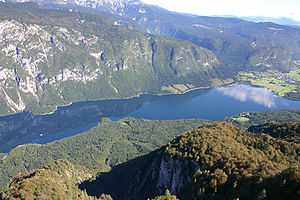Dragonja
| Dragonja | |
|---|---|
|
The outflow of the Dragonja into the Gulf of Piran | |
| Origin | Poletiči (Koper) |
| Mouth | Adriatic Sea, Sečovlje Saltpans |
| Basin countries | Slovenia, Croatia |
| Length | 30 km (19 mi) |
| Source elevation | 315 m (1,033 ft) |
| Basin area | 95.6 km2 (36.9 sq mi) |
The Dragonja (pronounced [dɾaˈɡoːnja]; Italian: Dragogna) is a 30-kilometre (19 mi) long river[1] in the northern part of the Istrian peninsula. It is a meandering river with a very branched basin and a small quantity of water. It often dries up in summer.[2] It features very diverse living environments and is home to a number of animal and plant species.[3] The Dragonja has been a matter of a territorial dispute between Croatia and Slovenia, with its lowest portion de facto the border of the two countries.[4]
Course
The river is the third longest river in Istria, after the Raša and Mirna rivers. It is the largest river of the Slovenian coast that flows into the Adriatic Sea.[5] It is also the only Slovenian river that does not flow through settlements and that flows in its entirety over the flysch terrain.[5]
The Dragonja originates in several sources in Šavrini Hills and flows west to the Gulf of Piran, part of the northern Adriatic Sea.[2] It gets two larger tributaries from the right side (the Rokava and the Drnica Creeks) and one larger from the left side (the Poganja Creek).[2]
The Sečovlje Salina Landscape Park with the Sečovlje Saltworks is located at its mouth. The lowest part of the Dragonja in the Municipality of Piran has been protected since 1990 as a natural monument.[2]
Name
The Dragonja River was first attested in written sources as Argao (ablative Argaone),[6] and in later sources as Argaone (in 670), per Argaonem (in 1035), Dragugne (in 1100), and super flumine Dragone (in 1389). The modern Slovene and Italian names (with initial D-) are derived from Slavic *Dorgon’a, from Romance d- (< ad 'at') + Argaon- (with metathesis). Ultimately, the name is of pre-Romance origin, presumably based on the Proto-Indo-European root *h2arg’- 'shining'.[7][8]
Non-linguistic accounts explain the name as based on the meandering course of the river, resembling a dragon (Italian: drago).[2]
Territorial dispute
In the lower reaches of the Dragonja, there is a territorial dispute between Slovenia and Croatia: while Croatian authorities claim that the Dragonja is a border river, Slovenia claims a strip of territory south to the river as well.[9] As of 2012, the last 7 kilometres (4.3 miles) of Dragonja's course is de facto border of Croatia and Slovenia. The disputed territory contains four hamlets and Croatia's Plovanija border crossing.[10] Dragonja River became a district border river after World War II, when Yugoslav administered Zone B of the Free Territory of Trieste (FTT) was split into Koper and Buje districts. After dissolution of the FTT in 1954 and transfer of its former Zone B to Yugoslavia, Koper district became a part of Slovenia while Buje district was attached to Croatia.[11]
References
| Wikimedia Commons has media related to Dragonja. |
- ↑ "Reke, dolge nad 25 km, in njihova padavinska območja" [Rivers, longer than 25 km, and their catchment areas] (in Slovene and English). Statistical Office of the Republic of Slovenia. 2002.
- ↑ 2.0 2.1 2.2 2.3 2.4 Trobec, Tanja. "Dragonja" [The Dragonja]. In Šmid Hribar, Mateja; Golež, Gregor; Podjed, Dan; Kladnik, Drago; Erhartič, Bojan; Pavlin, Primož; Ines, Jerele. Enciklopedija naravne in kulturne dediščine na Slovenskem – DEDI [Encyclopedia of Natural and Cultural Heritage in Slovenia] (in Slovenian). Retrieved 23 May 2012.
- ↑ Vovk Korže, Ana; Vrhovšek, Danijel (2008). "Možnosti sonaravnega regionalnega razvoja v porečju Dragonje z ekoremediacijami" [The Opportunities for a Natural Regional Development in the Dragonja Basin with Ecoremediations] (PDF). Ekolist: revija o okolju (in Slovenian) (5): 24–29. ISSN 1854-3758.
- ↑ Pipan, Primož (2008). "Border dispute between Croatia and Slovenia Along the Lower Reaches of the Dragonja River" (PDF). Acta geographica Slovenica (in English and Slovene) 48 (2): 343.
- ↑ 5.0 5.1 Krivograd Klemenčič, Aleksandra; Vrhovšek, Danijel; Smolar-Žvanut, Nataša (31 March 2007). "Microplanktonic and Microbenthic Algal Assemblages in the Coastal Brackish Lake Fiesa and the Dragonja Estuary (Slovenia)". Natura Croatica (Croatian Natural History Museum) 16 (1).
- ↑ Kos, Milko. 1985. Srednjeveška zgodovina Slovencev. Ljubljana: Slovenska matica Ljubljana, p. 137.
- ↑ Snoj, Marko. 2009. Etimološki slovar slovenskih zemljepisnih imen. Ljubljana: Modrijan and Založba ZRC, pp. 121–122.
- ↑ Bezlaj, France. 1967. Eseji o slovenskem jeziku. Ljubljana: Mladinska knjiga, p. 81.
- ↑ Pipan, Primož (2008). "Border dispute between Croatia and Slovenia along the lower reaches of the Dragonja River" (PDF). Acta geographica Slovenica 48 (2): 331–356. doi:10.3986/AGS48205. Retrieved 8 April 2010.
- ↑ "Drnovšek: Granica na Dragonji ako se uvaži sporazum s Račanom" [Drnovšek: The border is at Dragonja if Račan agreement is respected] (in Croatian). Index.hr. 27 August 2004. Retrieved 15 October 2012.
- ↑ Damir Josipovič (June 2012). "Slovenian-Croatian boundary: Backgrounds of boundary-making and boundary-breaking in Istria regarding the contemporary border dispute". Geoadria (Croatian Geographic Society, University of Zadar) 17 (1): 25–43. ISSN 1331-2294. Retrieved 15 October 2012.
| ||||||||||||||||||
| ||||||||||||||||||||||||||||||||||||
Coordinates: 45°28′42″N 13°35′10″E / 45.47833°N 13.58611°E

